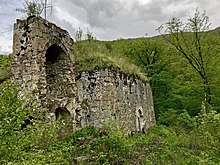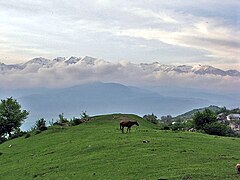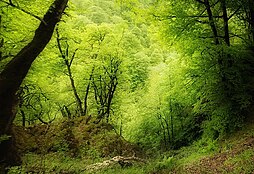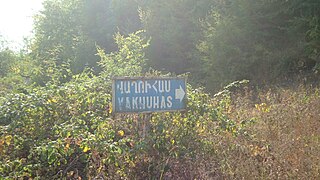Vaghuhas
Vaghuhas
Վաղուհաս | |
|---|---|
| Qozlu | |
 | |
 Vaghuhas | |
| Coordinates: 40°06′52″N 46°28′47″E / 40.11444°N 46.47972°ECoordinates: 40°06′52″N 46°28′47″E / 40.11444°N 46.47972°E | |
| Country (de facto) | |
| • Province | Martakert |
| Country (de jure) | |
| • District | Kalbajar |
| Elevation | 988 m (3,241 ft) |
| Population (2015)[1] | |
| • Total | 678 |
| Time zone | UTC+4 (AMT) |
Vaghuhas (Armenian: Վաղուհաս) or Gozlu (Azerbaijani: Qozlu) is a village de facto in the Martakert Province of the self-proclaimed Republic of Artsakh, de jure in the Kalbajar District of Azerbaijan. The village has an ethnic Armenian-majority population, and also had an Armenian majority in 1989.[2]
History[]

During the Soviet period, the village was a part of the Mardakert District of the Nagorno-Karabakh Autonomous Oblast.
Historical heritage sites[]
Historical heritage sites in and around the village include the ruins of the ancient Armenian settlement of Mayrakahag (Armenian: Մայրաքաղաք), including the Tiramayr Monastery (Armenian: Տիրամայր Վանք) built in 1183,[3] an 8th/9th-century chapel, a 12th/13th-century cemetery, the monastery of Khatravank (Armenian: Խաթրավանք) built in 1204, the monastery of Karmir Vank (Armenian: Կարմիր վանք) built in 1224, and the medieval village of Hin Vaghuhas (Armenian: Հին Վաղուհաս, lit. 'Old Vaghuhas').[1]
Economy and culture[]
The population is mainly engaged in agriculture and animal husbandry. As of 2015, the village has a municipal building, a house of culture, a secondary school, seven shops, and a medical centre.[1]
Demographics[]
The village had 638 inhabitants in 2005,[4] and 678 inhabitants in 2015.[1]
Gallery[]

Scenery around Vaghuhas

Forest near the village
A sign in Armenian reading "Vaghuhas"

Khachkars of Khatravank

Forest near the village

Aerial view of Vaghuhas

Interior of Khatravank
References[]
- ^ a b c d Hakob Ghahramanyan. "Directory of socio-economic characteristics of NKR administrative-territorial units (2015)".
- ^ Андрей Зубов. "Андрей Зубов. Карабах: Мир и Война". drugoivzgliad.com.
- ^ Ш. Мкртчян / Майракахак или монастырь Тирамайр /Историко-архитектурные памятники Нагорно-Карабаха/ стр. 47-48 (360)
- ^ "The Results of the 2005 Census of the Nagorno-Karabakh Republic" (PDF). National Statistic Service of the Republic of Artsakh.
External links[]
| Wikimedia Commons has media related to Vaghuhas. |
- Populated places in Martakert Province
- Populated places in Kalbajar District










